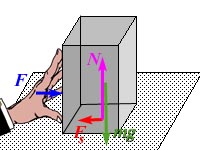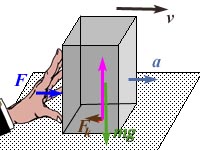 The
force of static friction is given by
The
force of static friction is given byThe force of friction depends on the properties of the surface between the two objects (which will determine the friction coefficient) and on the normal force. (On a flat surface, the normal force, N, is just the weight, mg.)
 The
force of static friction is given by
The
force of static friction is given by
In the upper figure, the applied external force is not big enough to overcome the static friction force, and the object remains at rest. Please note that the length of the red arrow (friction force) is exactly the same as that of the external force of the pushing hand, blue arrow. Also, please note that the length of the narrow of the normal force, purple arrow, is exactly the same as that of the weight of the object, green arrow. This means that in this case all forces are balanced and add up to 0 net force => the object remains at rest.
 Once
the object is moving, we have the force of kinetic
friction, Fk, acting in the opposite direction of
the motion, see lower figure on the right. The magnitude of the
kinetic friction force is:
Once
the object is moving, we have the force of kinetic
friction, Fk, acting in the opposite direction of
the motion, see lower figure on the right. The magnitude of the
kinetic friction force is:
where
In general, the coefficient of static friction,
In fact, could it be otherwise? If kinetic friction were greater than static friction, a force just big enough to overcome static friction would be too small to keep the body going.
© MultiMedia Physics, 1999